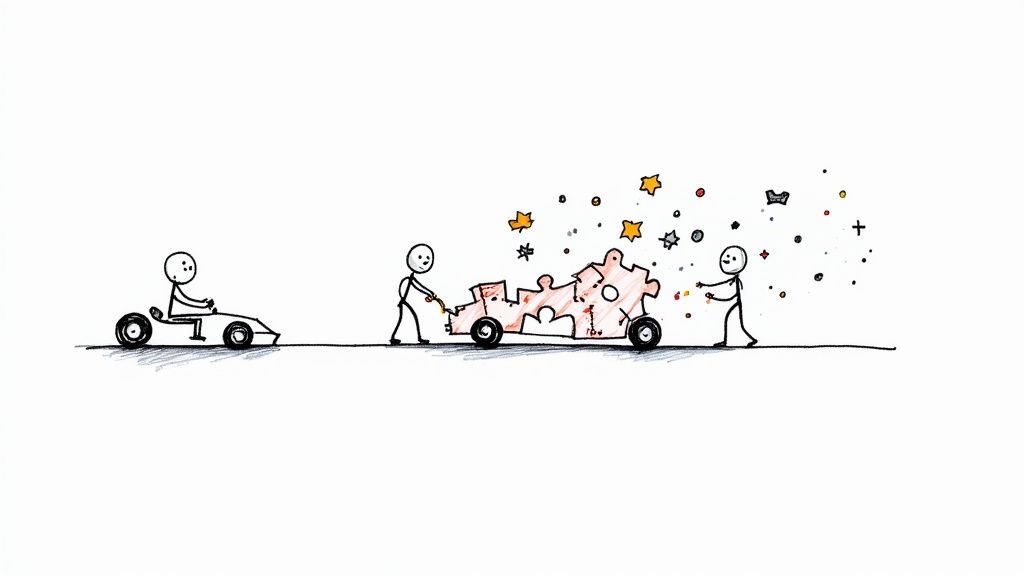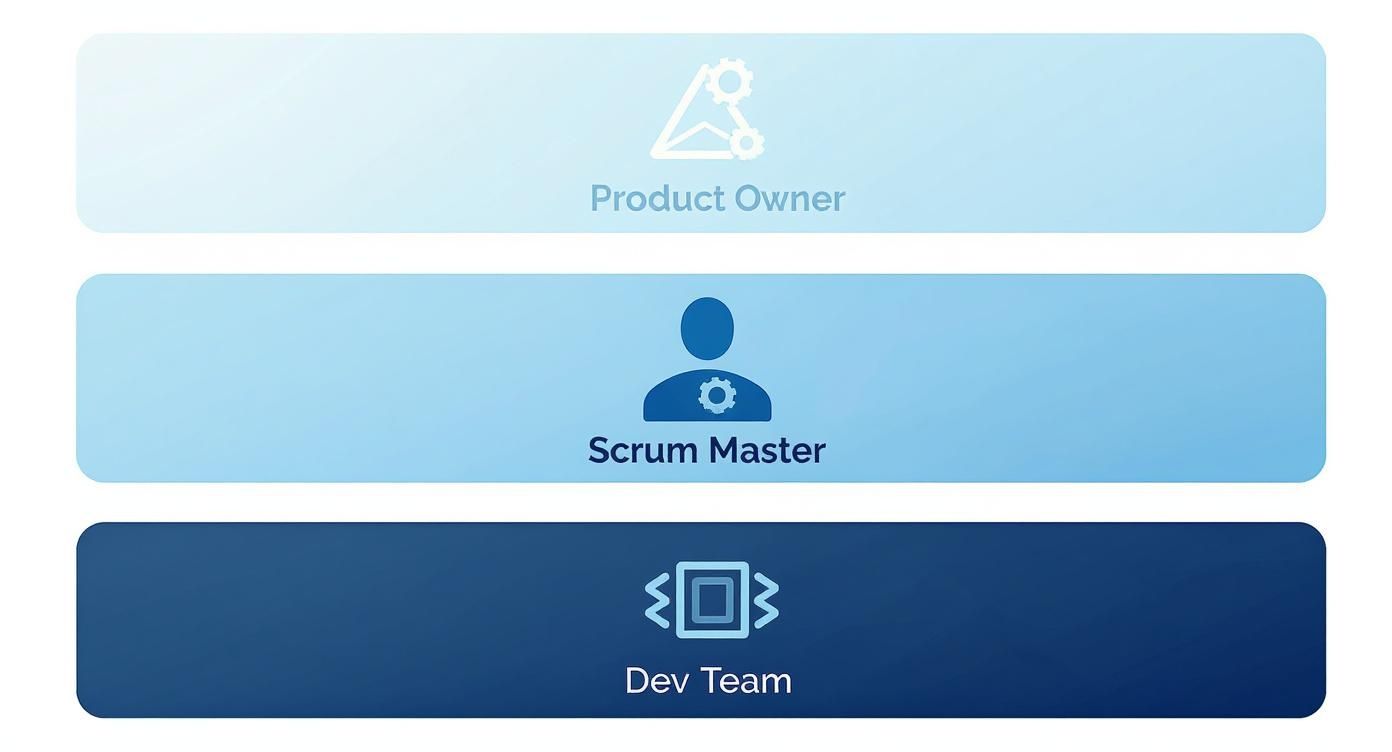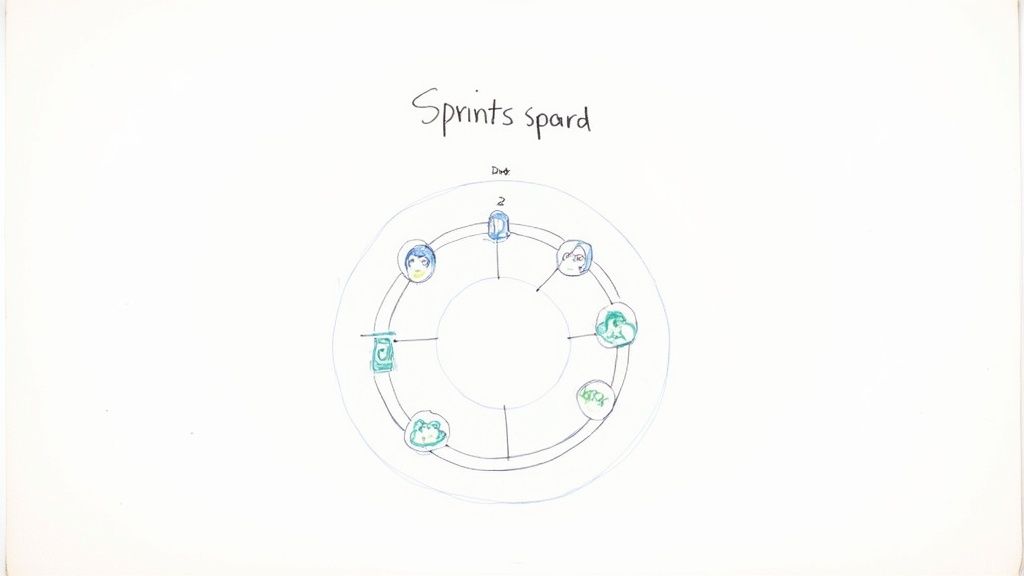TL;DR: Your Quick Action Plan
- Core Trio: Every Agile team needs a Product Owner (sets the what), a Development Team (builds it), and a Scrum Master or Tech Lead (enables the how).
- Startup vs. Scale-Up: A startup MVP team (3–5 people) combines roles (Founder as PO, Senior Dev as Tech Lead/Scrum Master). A scale-up team (5–9 people) needs dedicated specialists like MLOps or QA engineers.
- Leadership Shift: Modern Agile teams increasingly favor a Tech Lead over a non-technical Scrum Master to guide both process and architecture, speeding up problem-solving.
- Hiring Smart: Don't just check for certifications. Use situational interview questions and practical take-home tests to vet how candidates handle trade-offs, technical decisions, and team dynamics.
- Next Step: Use the checklist below to map your current team structure against the ideal models and identify your next critical hire.
Who This Guide Is For
This guide is for technical leaders who need to build or scale a high-performing software team, fast.
- CTO / Head of Engineering: You need to define roles, structure teams for new projects (especially AI), and make critical hiring decisions.
- Founder / Product Lead: You're building an MVP or adding a major feature and need a lean, effective team structure that won't break the bank.
- Hiring Manager / Talent Ops: You're sourcing and vetting candidates and need to know what skills actually matter for key Agile roles.
This is a no-fluff playbook to help you make smart team-building decisions in weeks, not months.
The Core Agile Roles: A Practical Framework

alt text: Stick figures collaborating to build and push puzzle-piece vehicle with creative sparks flying, representing the synergy in agile roles.
Building a high-performing agile team isn’t about titles; it’s about creating a system with clear responsibilities that delivers business value. Your goal is to empower a small, cross-functional team to own features from idea to launch.
Getting this structure right directly impacts your time-to-market and ability to pivot. It’s the difference between shipping quality software and getting stuck in endless meetings.
The Three Core Roles
Any effective Agile team balances three key responsibilities. This clear separation of concerns prevents confusion and empowers each role to focus on what they do best. The industry has standardized around these roles; the 17th Annual State of Agile Report shows that Product Owners alone now account for 36% of all Agile practitioners, signaling how central this structure has become.

alt text: A diagram showing the three key roles in agile software development: the Product Owner (representing the "what"), the Scrum Master (the "how"), and the Development Team (the builders).
1. The Product Owner: The Value Maximizer
The Product Owner (PO) is accountable for the product's success. They are the voice of the customer and the final decision-maker on what the team builds. A great PO is obsessed with maximizing the value delivered by the development team's work.
- Key Responsibilities: Owns and ruthlessly prioritizes the product backlog, acts as the primary liaison with stakeholders, and defines clear acceptance criteria for what "done" means.
- Business Impact: Directly connects development work to business goals, ensuring every sprint delivers measurable value and reduces the risk of building the wrong thing.
- Anti-Pattern to Avoid: The "backlog administrator" who just takes orders. A true PO needs the authority to say "no" based on data and strategy, not just stakeholder pressure.
2. The Scrum Master: The Team Enabler
The Scrum Master is a servant-leader whose job is to create an environment where the team can perform at its peak. They are part coach and part problem-solver, focused on process health and removing obstacles.
- Key Responsibilities: Facilitates Agile ceremonies (stand-ups, retrospectives), removes impediments blocking the team, and coaches the team on Agile principles for continuous improvement.
- Business Impact: Increases team velocity and predictability by eliminating friction and protecting the team from outside distractions.
- A Note on the Tech Lead: As we'll cover later, many modern teams—especially in engineering-led organizations—are replacing this role with a Tech Lead who provides both process guidance and technical leadership.
3. The Development Team: The Builders
The Development Team is the cross-functional group of professionals who build the product. This includes anyone required to turn an idea into a releasable feature: software engineers, QA analysts, UX designers, and MLOps engineers.
- Key Traits: They are self-organizing (pulling work from the backlog), cross-functional (possessing all skills needed to deliver), and committed to quality (building it in from the start).
- Business Impact: A cohesive, skilled development team is the engine of value creation. Their efficiency and quality directly determine product success.
Understanding the broader landscape of jobs in software engineering can help you build a more well-rounded and capable team.
2 Practical Examples: Team Structure by Growth Stage
The right Agile structure depends on your company's stage and goals. A startup racing to an MVP has different needs than a scale-up integrating a complex AI feature. Mapping roles incorrectly either wastes money or creates critical gaps that slow you down.
Example 1: The Startup Pod for an MVP Launch
Early on, speed and flexibility are everything. The goal is to ship a Minimum Viable Product (MVP) to validate an idea with real users. Your team must be lean and multi-skilled. Roles often overlap; the founder is typically the de-facto Product Owner.
The 5-Person Startup Pod:
- Product Owner: The Founder (owns the vision, makes rapid priority calls).
- Tech Lead/Scrum Master: A senior full-stack engineer (guides tech strategy, removes blockers).
- Full-Stack Developers (2): Generalists comfortable working across the entire stack.
- UX/UI Designer: Creates user flows, wireframes, and assets just ahead of development.
Real-World 90-Day MVP Plan:
- Month 1 (Sprints 1-2): Build the core user journey: user authentication, primary data model, and one critical feature. The goal is an internal-use-only prototype.
- Month 2 (Sprints 3-4): Add supporting features, refine the UI based on internal feedback, and establish a basic CI/CD (Continuous Integration/Continuous Deployment) pipeline.
- Month 3 (Sprints 5-6): Conduct User Acceptance Testing (UAT) with a small group of beta testers, fix critical bugs, and prepare for a limited launch.
Example 2: The Scale-Up Squad for an AI Feature
As a company grows, it can afford specialists to tackle complexity and reduce risk. Integrating an AI-powered feature requires a team with a different composition to manage the unique lifecycle of machine learning models. Many companies use software development team augmentation to add these niche skills quickly.
The 8-Person AI Feature Squad:
- Product Owner: A dedicated PM with experience in AI/ML products.
- Scrum Master: A full-time facilitator focused on process health.
- Backend Engineers (2): Focus on APIs and data processing pipelines.
- Frontend Engineer: Builds the user interface for the AI feature.
- MLOps Engineer: Manages infrastructure for training, deploying, and monitoring ML models. This is a critical, non-negotiable role.
- Data Scientist: Develops, trains, and evaluates the core algorithms.
- UX Designer: Designs intuitive interfaces for presenting AI-driven insights.
Scaling Your Team: Essential Supporting Roles

alt text: Hand-drawn diagram of a sprint board with team members in a circular workflow, illustrating the continuous process of agile development.
As you scale, the core trio needs specialized support to maintain velocity and quality. These roles embed deep skills into your workflow, preventing technical debt and improving user experience.
- UX/UI Designers: They work inside the sprint, not as an external service. They conduct user research, create just-in-time designs for upcoming stories, and build a reusable design system.
- QA Engineers: They shift quality "left," building automated test suites and working with the PO on acceptance criteria before development starts. They become quality coaches for the entire team.
- DevOps and MLOps Engineers: DevOps automates the CI/CD pipeline for application code. The more specialized MLOps Engineer does the same for the complex lifecycle of machine learning models—automating training, validation, deployment, and monitoring.
- Data Scientists and Analysts: They provide the evidence needed for data-driven decisions. They validate hypotheses, design A/B tests, and provide insights that help the Product Owner prioritize the backlog for maximum business impact.
Deep Dive: The Shift to Technical Leadership
https://www.youtube.com/embed/xfX_2EF8FTQ
A major shift is underway: companies are moving away from process-focused Scrum Masters and empowering technical leaders—Tech Leads and Staff Engineers—to guide the Agile process.
This change is a direct response to the need for faster, more effective problem-solving. A non-technical Scrum Master can only facilitate a discussion about a technical blocker. A Tech Lead can facilitate that same discussion and roll up their sleeves to help fix the problem.
Data from the 17th State of Agile Report confirms this trend: engineering and R&D teams now make up 48% of all Agile practitioners, a 16% jump from 2022. Technical teams are increasingly owning their own process.
In software development, the process should serve the work, not the other way around. When the person guiding the process deeply understands the work, the whole team wins. For more on managing team performance, see these best practices for performance management.
Checklist: How to Hire for Key Agile Roles
Hiring the right people is the most critical factor in building a successful Agile team. This checklist provides a framework and specific questions to vet candidates for the three most pivotal roles. When budgeting, defining a competitive salary is essential for attracting top talent.
Hiring Checklist and Interview Kit
✅ 1. Screen for a Product Owner
A great PO is a master of prioritization and a skilled diplomat. Your interview must probe their ability to handle tough trade-offs.
- Situational Question: "Walk me through a time you had to say 'no' to a key stakeholder. How did you use data or a framework (like RICE) to justify your decision and maintain the relationship?"
- Core Skill to Test: Data-informed decision-making and stakeholder management.
✅ 2. Vet a Scrum Master or Agile Coach
The best Scrum Masters are servant leaders, not project managers. You need to know if they can improve team dynamics and remove real-world blockers.
- Situational Question: "Two senior engineers are deadlocked on a technical approach, and it’s derailing sprint planning. What is your action plan?"
- Core Skill to Test: Conflict resolution and facilitation.
✅ 3. Test a Tech Lead
A Tech Lead's value is in making smart architectural choices and communicating them clearly. A short, practical take-home exercise is the best way to assess this.
- Example Take-Home Brief: "You're the new Tech Lead for a team building a real-time chat feature. In a one-page document, sketch out your proposed system architecture. Include a simple diagram, your tech stack choices (with a brief 'why'), and the top 3 technical risks you foresee."
- Core Skills to Test: System design, technical communication, and risk assessment.
What to Do Next
- Assess Your Current Team: Use the "Startup vs. Scale-Up" models to benchmark your current team structure. Identify any role gaps or overlaps.
- Define Your Next Hire: Based on your assessment, determine the single most critical role you need to hire for next. Is it a dedicated Product Owner, an MLOps specialist, or a Tech Lead?
- Book a Scoping Call: If you need to hire elite, pre-vetted AI or software engineers, we can help you build your team in days, not months.
Building a high-performing AI team starts with hiring the right talent for these critical roles. ThirstySprout's network of pre-vetted AI and software engineering experts can help you find the specialists you need.
References
- Digital.ai. (2023). 17th State of Agile Report. Retrieved from https://digital.ai/resource-center/analyst-reports/state-of-agile-report
- Businessmap. (2024). Agile Statistics. Retrieved from https://businessmap.io/blog/agile-statistics
Hire from the Top 1% Talent Network
Ready to accelerate your hiring or scale your company with our top-tier technical talent? Let's chat.

